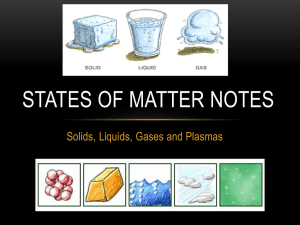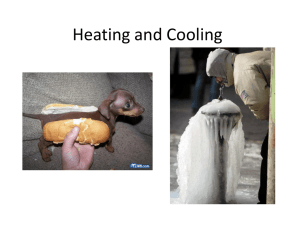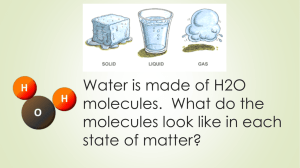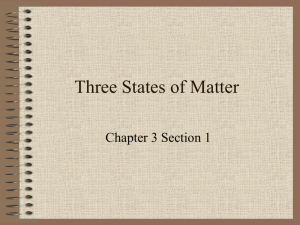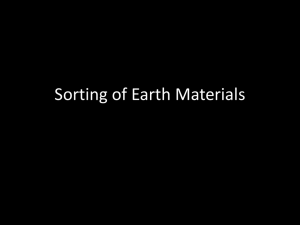Unit 1 Lesson 5
advertisement
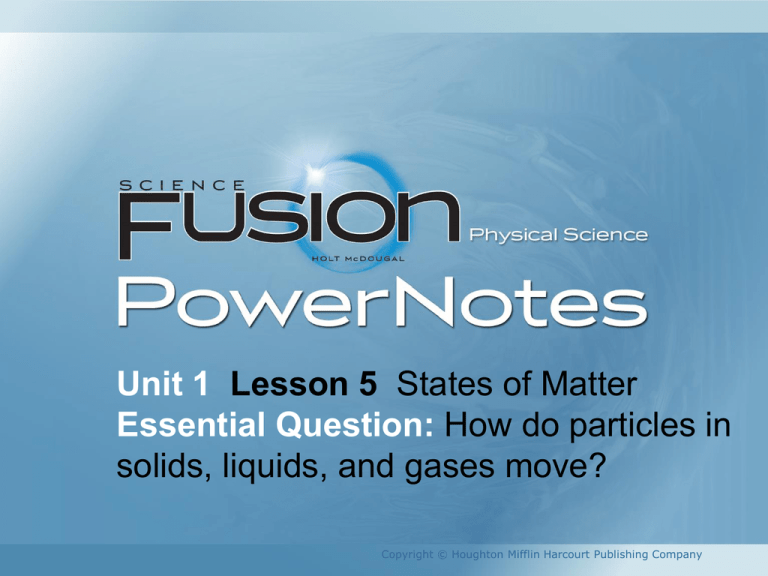
Unit 1 Lesson 5 States of Matter Essential Question: How do particles in solids, liquids, and gases move? Copyright © Houghton Mifflin Harcourt Publishing Company Unit 1 Lesson 5 States of Matter P66 Particles in Motion How do particles move in solids, liquids, and gases? • The kinetic theory of matter states that all matter is made of tiny particles that are in constant motion. • The state of matter is determined by how much particles move and how often they bump into each other. P66-69 Solid Liquid Gas • • • • • • • • • • • • • • • • • • Unit 1 Lesson 5 States of Matter P67 How do particles move in solids, liquids, and gases? • A solid is a substance with a definite volume and shape. Particles are close together and do not move freely. • A liquid is a substance with a definite volume but not a definite shape. • A gas is a substance that does not have a definite volume or shape. Unit 1 Lesson 5 States of Matter P68 Shape Up! How does particle motion affect the properties of solids, liquids, and gases? • Particles in a solid vibrate but remain in fixed positions. • Solids cannot easily change shape or volume. Unit 1 Lesson 5 States of Matter P69 How does particle motion affect the properties of solids, liquids, and gases? • Liquids take the shape of their container. Particles in a liquid are close together but not tightly arranged. • Particles in liquids slide past each other, creating flow. Unit 1 Lesson 5 States of Matter P69 How does particle motion affect the properties of solids, liquids, and gases? • Particles in gases are far apart. • The space between gas particles can change easily. • Gases take on the shape of their container. Solid Liquid Gas • Definite volume and shape. • Particles vibrate. • Particles remain in fixed positions. • Particles are close together. • Cannot easily change shape or volume. • Definite volume but not a definite shape. • Liquids take the shape of their container. • Particles in a liquid are close together but not tightly arranged. • Particles in liquids slide past each other, creating flow. • Do not have a definite volume or shape. • Particles in gases are far apart. • The space between gas particles can change easily. • Gases take on the shape of their container • Volume will not change; will always find a way to fill the entire container. Unit 1 Lesson 5 States of Matter P70 What happens when substances change state? • The process in which a solid becomes a liquid is called melting. • As a solid is heated, if the vibrations in the particles are fast enough, the particles break loose and slide past one another. • When temperatures of a liquid are lowered, causing a solid to form, it is called freezing. • Lower temperatures cause the particles to move slowly enough for the attractions between them to cause the liquid to become a solid. • Water freezes at 0°C, but other substances can freeze at room temperature. • When substances lose or gain energy, one of two things can happen to the substance: its temperature can change or its state can change. Unit 1 Lesson 5 States of Matter P70 What happens when substances change state? • When substances lose or gain energy, one of two things can happen to the substance: • its temperature can change • or its state can change. Unit 1 Lesson 5 States of Matter P70



